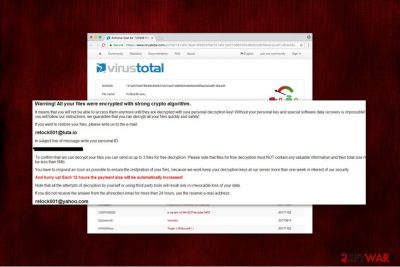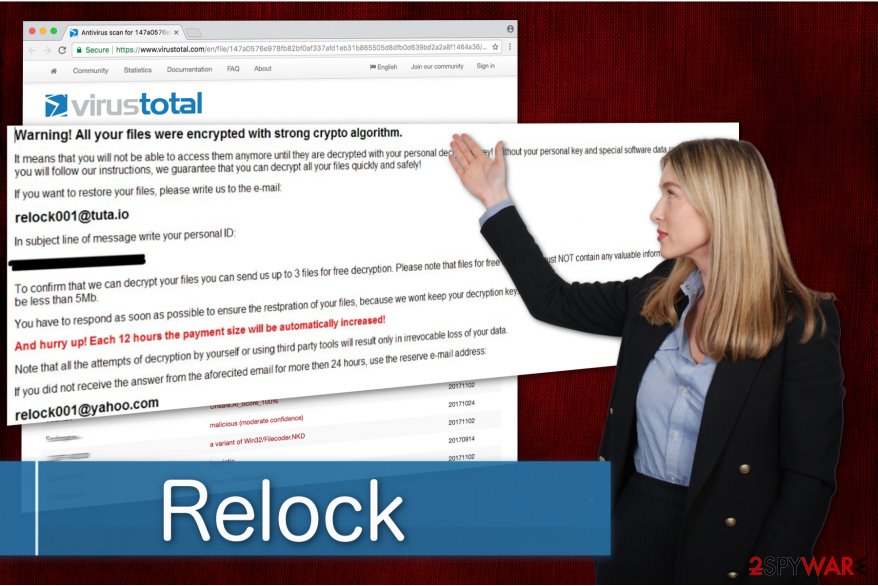Relock ransomware / virus (Bonus: Decryption Steps) - Virus Removal Guide
Relock virus Removal Guide
What is Relock ransomware virus?
Relock ransomware virus urges to contact the criminals for a decryption tool

Relock ransomware is a file-encrypting virus that blocks the access to your data and demands a ransom. Analysts believe that it might be a new variant of an infamous Matrix ransomware. After the infiltration, victims receive a !OoopsYourFilesLocked!.rtf ransom note and are urged to pay a ransom since it states that the amount of payment increases every 12 hours. Criminals provide relock001@tuta.io and relock001@yahoo.com e-mail addresses for contact purposes.
Hackers warn people not to use alternative decryption tools as it will only lead to permanent damage of the data. To gain victim’s trust, they offer a free decryption of 3 files. They must not be bigger than 5 MB and shouldn’t contain valuable information.
However, we neither encourage you to trust the criminals nor purchase useless decryptors online. Malevolent people aim for quick profits and usually do not keep their promises[1]. Instead, start a Relock removal immediately and try to recover your files using alternative methods.
ZonderVirus.nl[2] experts discovered that the malware only encrypts documents and archive files. However, they use sophisticated algorithmic methods and leave the data completely corrupted. Relock virus blocks the access to your files by appending _[RELOCK001@TUTA.IO].* file extension. Therefore, we always suggest keeping backup copies in case of ransomware. If you store them in the cloud or another external device, you should be able to quickly retrieve them and avoid financial losses.
According to the VirusTotal.com analysis, Relock virus is recognized as VJdbqn9n.exe_ and successfully detected by anti-malware software. Therefore, we strongly recommend not to try to remove Relock ransomware by yourself. You should employ a professional security system such as FortectIntego and get rid of the file-encrypting virus automatically.

Crooks use malspam campaigns to distribute ransomware
One of the most popular methods used by cybercriminals to distribute malware — send spam e-mail messages containing a malicious attachment[3]. It is set to download an executable file of the malware as soon as the victim opens it.
Developers often design those letter to look extremely genuine and gullible people are tricked to install ransomware unconsciously. Spam e-mails may be sent from reputable institutions or campaigns that provide useful services. You can encounter virus sent as a fake invoice or another document.
Thus, we encourage you to be extremely careful when opening messages from unknown senders. Be aware that crooks may also hack into social networking accounts and spread the infected links. In case of a suspicious letter, do not click on it and always contact your friend in person and make sure that his or her account is safe.
Get rid of the Relock ransomware with the help of an anti-malware program
You can remove Relock virus by employing a trustworthy security software. However, ransomware developers may set it to block the installation of the anti-virus system. Therefore, you should reboot your computer to Safe Mode and then run a full system scan.
If you want to start a manual Relock removal, follow the guide provided below. This way you will safely eliminate the virus and do not cause more damage to your files. Shortly after, you will be able to try to recover your data. There are several alternative methods which can help to bet back the access to your files, and you can check them at the end of this article.
Getting rid of Relock virus. Follow these steps
Manual removal using Safe Mode
Relock virus is a harmful ransomware. Thus, it might block the installation of a professional anti-malware system. To avoid that, you should reboot your computer to Safe Mode and download the security software. A detailed explanation is provided below.
Important! →
Manual removal guide might be too complicated for regular computer users. It requires advanced IT knowledge to be performed correctly (if vital system files are removed or damaged, it might result in full Windows compromise), and it also might take hours to complete. Therefore, we highly advise using the automatic method provided above instead.
Step 1. Access Safe Mode with Networking
Manual malware removal should be best performed in the Safe Mode environment.
Windows 7 / Vista / XP
- Click Start > Shutdown > Restart > OK.
- When your computer becomes active, start pressing F8 button (if that does not work, try F2, F12, Del, etc. – it all depends on your motherboard model) multiple times until you see the Advanced Boot Options window.
- Select Safe Mode with Networking from the list.

Windows 10 / Windows 8
- Right-click on Start button and select Settings.

- Scroll down to pick Update & Security.

- On the left side of the window, pick Recovery.
- Now scroll down to find Advanced Startup section.
- Click Restart now.

- Select Troubleshoot.

- Go to Advanced options.

- Select Startup Settings.

- Press Restart.
- Now press 5 or click 5) Enable Safe Mode with Networking.

Step 2. Shut down suspicious processes
Windows Task Manager is a useful tool that shows all the processes running in the background. If malware is running a process, you need to shut it down:
- Press Ctrl + Shift + Esc on your keyboard to open Windows Task Manager.
- Click on More details.

- Scroll down to Background processes section, and look for anything suspicious.
- Right-click and select Open file location.

- Go back to the process, right-click and pick End Task.

- Delete the contents of the malicious folder.
Step 3. Check program Startup
- Press Ctrl + Shift + Esc on your keyboard to open Windows Task Manager.
- Go to Startup tab.
- Right-click on the suspicious program and pick Disable.

Step 4. Delete virus files
Malware-related files can be found in various places within your computer. Here are instructions that could help you find them:
- Type in Disk Cleanup in Windows search and press Enter.

- Select the drive you want to clean (C: is your main drive by default and is likely to be the one that has malicious files in).
- Scroll through the Files to delete list and select the following:
Temporary Internet Files
Downloads
Recycle Bin
Temporary files - Pick Clean up system files.

- You can also look for other malicious files hidden in the following folders (type these entries in Windows Search and press Enter):
%AppData%
%LocalAppData%
%ProgramData%
%WinDir%
After you are finished, reboot the PC in normal mode.
Remove Relock using System Restore
If the first method failed, reboot your computer to Safe Mode using Command Prompt:
-
Step 1: Reboot your computer to Safe Mode with Command Prompt
Windows 7 / Vista / XP- Click Start → Shutdown → Restart → OK.
- When your computer becomes active, start pressing F8 multiple times until you see the Advanced Boot Options window.
-
Select Command Prompt from the list

Windows 10 / Windows 8- Press the Power button at the Windows login screen. Now press and hold Shift, which is on your keyboard, and click Restart..
- Now select Troubleshoot → Advanced options → Startup Settings and finally press Restart.
-
Once your computer becomes active, select Enable Safe Mode with Command Prompt in Startup Settings window.

-
Step 2: Restore your system files and settings
-
Once the Command Prompt window shows up, enter cd restore and click Enter.

-
Now type rstrui.exe and press Enter again..

-
When a new window shows up, click Next and select your restore point that is prior the infiltration of Relock. After doing that, click Next.


-
Now click Yes to start system restore.

-
Once the Command Prompt window shows up, enter cd restore and click Enter.
Bonus: Recover your data
Guide which is presented above is supposed to help you remove Relock from your computer. To recover your encrypted files, we recommend using a detailed guide prepared by 2-spyware.com security experts.As mentioned above, the Relock removal does not recover your files — they remain inaccessible. However, our IT experts have prepared several methods you can try to retrieve your data.
If your files are encrypted by Relock, you can use several methods to restore them:
Data Recovery Pro might help you
This application is designed to recover accidentally deleted or wrecked files. Thus, it might be a useful tool after ransomware attack as well.
- Download Data Recovery Pro;
- Follow the steps of Data Recovery Setup and install the program on your computer;
- Launch it and scan your computer for files encrypted by Relock ransomware;
- Restore them.
Get help from ShadowExplorer
If you want to use it, make sure that the virus hasn't deleted Shadow Volume Copies from your system. If they are still there, you should definitely try to recover your data using ShadowExplorer.
- Download Shadow Explorer (http://shadowexplorer.com/);
- Follow a Shadow Explorer Setup Wizard and install this application on your computer;
- Launch the program and go through the drop down menu on the top left corner to select the disk of your encrypted data. Check what folders are there;
- Right-click on the folder you want to restore and select “Export”. You can also select where you want it to be stored.
Finally, you should always think about the protection of crypto-ransomwares. In order to protect your computer from Relock and other ransomwares, use a reputable anti-spyware, such as FortectIntego, SpyHunter 5Combo Cleaner or Malwarebytes
How to prevent from getting ransomware
Choose a proper web browser and improve your safety with a VPN tool
Online spying has got momentum in recent years and people are getting more and more interested in how to protect their privacy online. One of the basic means to add a layer of security – choose the most private and secure web browser. Although web browsers can't grant full privacy protection and security, some of them are much better at sandboxing, HTTPS upgrading, active content blocking, tracking blocking, phishing protection, and similar privacy-oriented features. However, if you want true anonymity, we suggest you employ a powerful Private Internet Access VPN – it can encrypt all the traffic that comes and goes out of your computer, preventing tracking completely.
Lost your files? Use data recovery software
While some files located on any computer are replaceable or useless, others can be extremely valuable. Family photos, work documents, school projects – these are types of files that we don't want to lose. Unfortunately, there are many ways how unexpected data loss can occur: power cuts, Blue Screen of Death errors, hardware failures, crypto-malware attack, or even accidental deletion.
To ensure that all the files remain intact, you should prepare regular data backups. You can choose cloud-based or physical copies you could restore from later in case of a disaster. If your backups were lost as well or you never bothered to prepare any, Data Recovery Pro can be your only hope to retrieve your invaluable files.
- ^ Matthew Hughes. Economists have figured out how to extract the most profit from ransomware. The Next Web. International Technology News, Business & Culture.
- ^ ZonderVirus. ZonderVirus. Security and Spyware News.
- ^ Cyber safety. How to Identify Spam and Phishing Messages. NAB Personal Banking. Insurance, Loans, Accounts, Credit Cards.





















